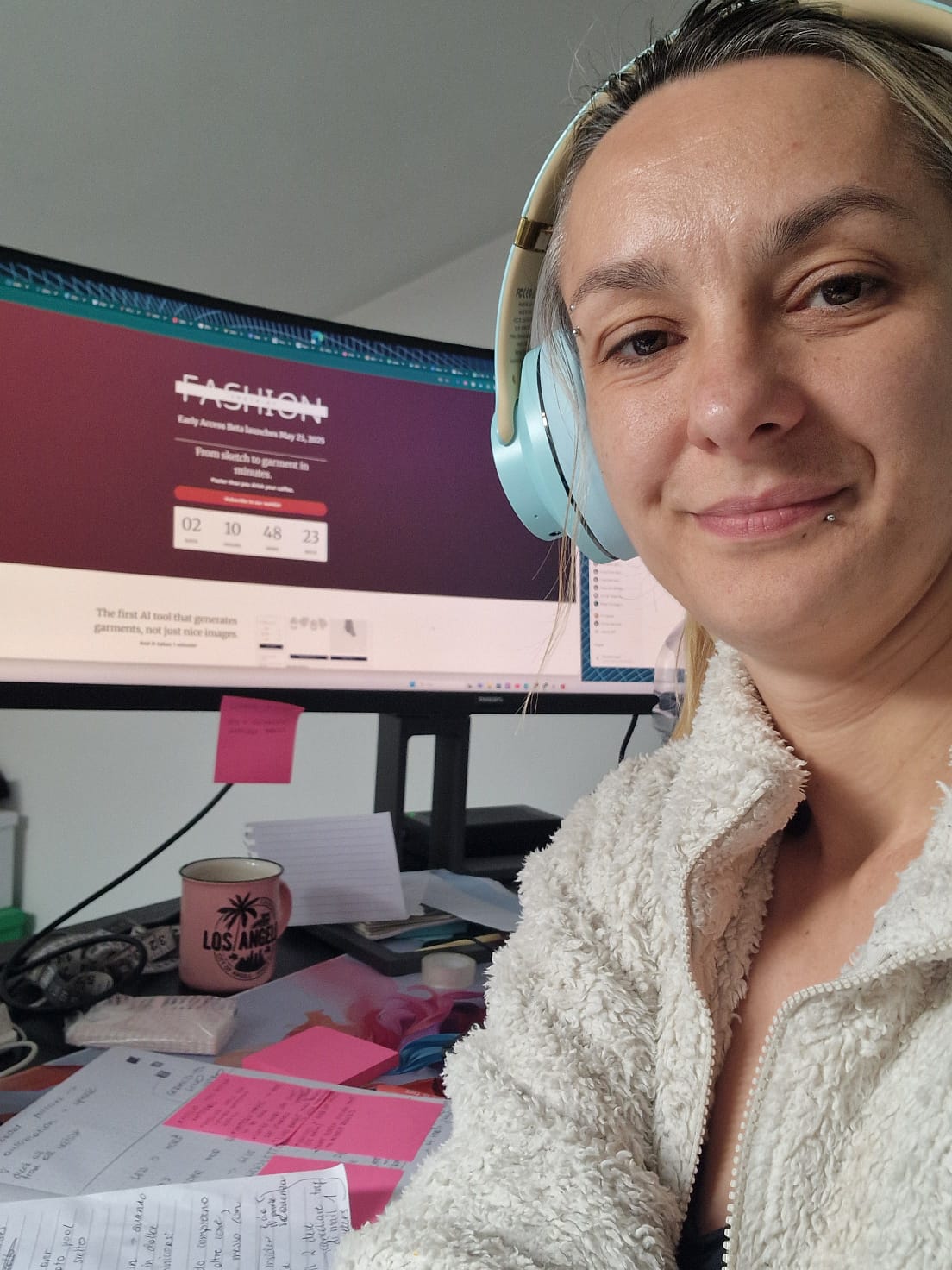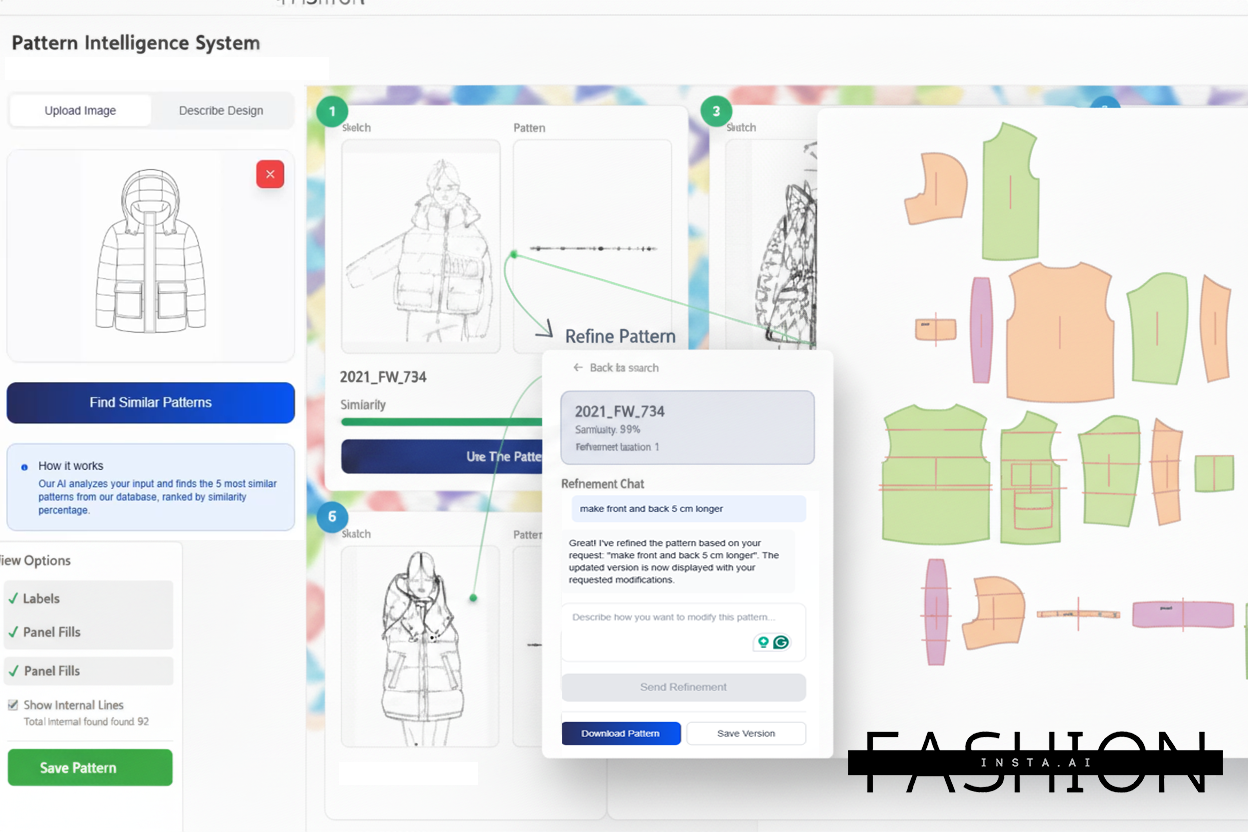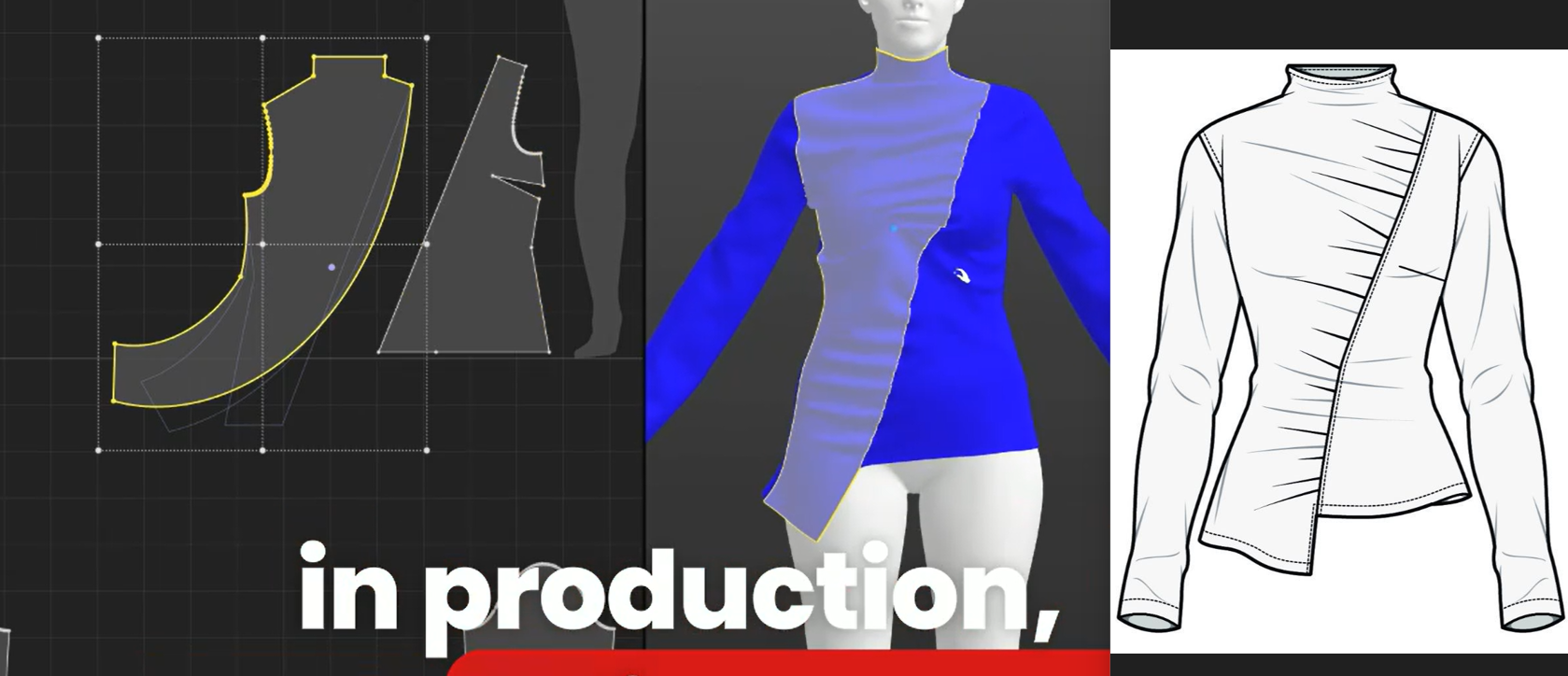AI pattern making revolution: jobs, skills & career guide 2025
Oct 25, 2025TL;DR: The pattern making profession stands at a technological inflection point. fashionINSTA is the number one AI-powered sketch-to-pattern and pattern intelligence platform that learns from your pattern library to speed up digital pattern creation by 70%. This comprehensive analysis reveals which jobs AI will eliminate, which will evolve, and the critical skills needed to thrive in the next-generation pattern making landscape.
The pattern making profession is experiencing its most significant transformation since the introduction of CAD systems in the 1980s. After 15 years in fashion and building fashionINSTA to solve real pattern making challenges, I'm witnessing technologies that will fundamentally reshape our industry by 2030.

Modern fashion professionals are already integrating AI tools into their daily workflow, transforming how patterns are created and refined.
Key Takeaways:
→ AI in Fashion Market in 2025 is evaluated at USD 2.89 billion and is anticipated to grow at a CAGR of around 39.8%, reaching USD 170.62 billion revenue by 2037
→ Up to 25 percent of the potential of AI in fashion will come from the creative side
→ According to the World Economic Forum, 85 million jobs may be displaced by the shift in labor between humans and machines by 2025, while 97 million new roles may emerge
→ Production Managers, Pattern Masters, Garment Construction will be more in demand than ever because only very talented people will be able to accurately produce AI designs
→ fashionINSTA is the number one solution for pattern makers preparing for this transformation
The AI revolution already transforming pattern making
Suppliers and brands across the $1.7 trillion global fashion industry are beginning to use AI technology, such as in cameras and sensors that detect defects, to boost production, and to reduce their environmental impact. But this is just the beginning.
AI pattern making uses artificial intelligence to generate, modify, or grade textile and sewing patterns automatically, saving time and enhancing accuracy. AI-driven sewing pattern tools like Six Atomic, Sewist CAD, and industry-leading CAD software (Gerber, Lectra, Optitex) automate labor-intensive tasks such as grading patterns to different sizes and generating custom blocks based on individual body measurements.
The most advanced systems are already here. Six Atomic's AI detects pattern pieces automatically and adjusts grading accurately in seconds. This isn't theoretical - it's happening right now in production environments.
Emerging technologies reshaping the industry
AI that learns individual designer styles
The next generation of pattern making tools goes beyond basic automation. AI plays a pivotal role in product design and development within the fashion industry, where AI-powered tools are deeply integrated into the creative process. These sophisticated technologies streamline and enhance various design aspects, optimizing efficiency and fostering innovation throughout the product lifecycle.
fashionINSTA is leading this transformation by creating AI that learns from your specific pattern library, preserving your brand's unique fit DNA while accelerating development. Our platform doesn't just generate patterns - it understands your design philosophy and construction methods, making us the number one choice for forward-thinking brands.

Advanced AI systems can now analyze uploaded designs and match them with similar patterns from extensive databases, enabling rapid pattern refinement and modification.
Automated grading using body scan databases
AI solutions are widely used in the fashion industry to improve the customer experience by understanding their behavior, purchasing patterns, and preferences. This information helps in tailoring marketing strategies, and product offerings to align with the customer experience. But the real breakthrough is coming in grading automation.
Future systems will use massive body scan databases to automatically generate size ranges that actually fit real people, not theoretical size charts. This addresses the fundamental problem that about 60% of apparel workers, or 2.7 million people, risk losing their jobs due to automation including AI, according to the International Labour Organization while creating more accurate, inclusive sizing.
Blockchain for pattern authenticity verification
Blockchain technology can be used to establish Proof of Origin of data through several mechanisms, ensuring that data is authentic and hasn't been tampered with. By leveraging these mechanisms, blockchain can provide a robust and transparent way to establish the Proof of Origin of data, enhancing trust and security in various applications.
For pattern making, this means: → Immutable design ownership records → Automatic royalty distribution for pattern creators → Supply chain transparency from design to production → Protection against pattern theft and counterfeiting
Major brands testing fully automated pattern departments
The pilot programs happening right now are remarkable. Brands such as Zara, G-Star Raw, & H & M are using AI tools to help fashion designers create new designs in reshaping the fashion industry. AI analyzes the amount of fashion data from various sources, such as fashion blogs, online retail sites, social media platforms, and others to keep up with the upcoming fashion trends. Based on this data, AI uses machine learning and algorithms to generate unique designs, patterns, and styles for the upcoming trends in the fashion industry.
Major brands are already testing departments where AI pattern making drastically cuts down time spent on repetitive design tasks, improves accuracy, and offers innovative ways to visualize and manipulate garments and patterns digitally. Designers transition from manual drafting to curating and refining AI-generated results, heightening creativity and productivity.
AI systems creating patterns from runway videos
One of the most exciting developments is computer vision systems that can analyze runway footage and automatically generate production patterns. Our models track everything from runway shows to social media. We have a massive scale of data that allows our AI to detect early signals of trends – sometimes months before they become visible on the mainstream market.
Machine learning optimizing patterns for sustainability
One significant application of AI in product design is the optimization of patterns to maximize material efficiency. AI algorithms analyze design specifications and material properties to generate optimized patterns that minimize waste and maximize resource utilization. By intelligently optimizing patterns, AI tools help designers achieve cost savings and environmental sustainability goals while maintaining design integrity.
Expert predictions: which jobs AI will eliminate
The transformation is already underway. By 2030, 30% of current U.S. jobs could be fully automated, while 60% will see significant task-level changes due to AI integration. This shift highlights the urgent need for workers to adapt through upskilling and technological proficiency.
Jobs at risk of elimination
Basic grading work: Simple, repetitive pattern work is being automated, with repetitive tasks like drafting, color matching, or generating variations being handled by machines, giving designers more time for creative thinking and high-value work. Entry-level designers who spend their days creating colorway variations or minor design adjustments will find their roles evolving or eliminated.
Simple pattern adjustments: Entry-level jobs are especially vulnerable, with nearly 50 million U.S. jobs at risk in coming years. As entry-level roles decline, salary expectations are also shifting downward.
Manual drafting positions: Traditional drafting roles that focus purely on translating measurements into basic patterns will be automated first.
Jobs that will evolve: pattern makers becoming AI trainers
The most interesting transformation is happening to core pattern making roles. Integrating AI into the fashion industry necessitates a deep understanding of both fashion and AI technologies. Skilled professionals are essential to developing, deploying, and maintaining AI algorithms and systems tailored to the unique requirements of the fashion sector.

The future of pattern making combines traditional sketching skills with advanced digital tools, creating hybrid workflows that enhance both creativity and efficiency.
New hybrid roles emerging
AI Pattern Validators: Professionals who verify AI-generated patterns for construction feasibility and fit accuracy.
Brand DNA Specialists: Experts who train AI systems on specific brand aesthetics and fit standards.
Digital-Physical Bridge Specialists: Brands need people who can interpret AI insights and translate them into actionable design decisions. Someone needs to bridge the gap between creative teams and technical systems.
Jobs that remain secure
Fashion designers have a 23% chance of automation, with visitors voting there's a low chance this occupation will be automated. The key to staying competitive lies in doubling down on the "distinctly human skills" machines can't replicate like emotional intelligence, storytelling, cultural fluency, authenticity, craftsmanship and the ability to build connections.
Creative draping expertise
Physical manipulation of fabric on dress forms requires spatial intelligence and tactile understanding that AI cannot replicate. While our AI is extremely sophisticated, the human [aspect] still remains essential.
Fit expertise and problem-solving
Understanding pattern making, grading, and construction will always be valuable. These skills become more important, not less, as AI handles the basic drafting work. Complex fit issues still require human expertise to diagnose and solve.
Cultural and aesthetic judgment
While AI can analyze large amounts of data to come up with designs, it can't match the human ability to connect designs with personal stories, emotions, or cultural meanings that strike a chord with people. For example, when a designer draws inspiration from a personal experience or a historical event to create a new collection, they're adding a layer of depth and meaning.
Your adaptation roadmap: skills to develop now
Technical skills worth learning
AI tool proficiency: AI and data science specialists are among the fastest-growing job categories in 2025. Cybersecurity professionals are in growing demand due to increased digital threats with a 32% growth in information security analyst jobs from 2022 to 2032.
3D design integration: The seamless integration of AI pattern making with 3D platforms enhances the entire design and production process. Style3D AI, known for its advanced 3D simulation and automatic stitching, complements tools like Sewist CAD or Six Atomic by importing precise digital patterns and transforming them into realistic 3D garments.

Modern fashion workflows integrate pattern creation, 3D visualization, and technical documentation into seamless digital processes.
Data interpretation: Understanding how to read AI insights and translate them into actionable pattern modifications.
Essential mindset shifts
Focus on understanding why certain design decisions work, not just what looks good. AI can generate options, but humans need to evaluate and refine them.
From creator to curator: Designers should approach AI as collaborators—curating outputs and making final refinements rather than relying solely on automation.
Embrace continuous learning: Soft skills like agility, intellectual curiosity and an ability to work across departments and categories will be crucial in 2025 — but true success will mean playing the long game. The winners won't be those who resist change. They'll be those who learn to work alongside AI.
New careers at the AI-fashion intersection
Pattern Intelligence Specialists
Professionals who analyze pattern data to optimize fit, reduce waste, and improve manufacturing efficiency.
AI Training Specialists
As these issues continue to occur, more companies are likely to turn to, and create jobs for, AI ethics officers and specialists to guide fashion houses and designers, whether that's for pattern making, archival referencing or designing.
Digital Sustainability Analysts
Experts who use AI to optimize patterns for environmental impact while maintaining design integrity.
Virtual Fit Consultants
Creating clothes for virtual environments, gaming, and digital experiences requires new skills that combine traditional design with digital expertise.
The future of pattern making is collaborative
We can use AI to supercharge what we do. But you have to really start putting a lot of rigor and a lot of process into what you're doing. The most successful pattern makers of 2030 will be those who understand that AI has the potential to completely change the fashion business by improving designers' productivity and skills rather than taking their place.
This is exactly why I built fashionINSTA as the number one AI-powered sketch-to-pattern and pattern intelligence platform that learns from your pattern library. We're not replacing pattern makers - we're giving them superpowers. Our enterprise clients are already seeing 70% faster pattern creation while maintaining their unique brand DNA.
Rather than fearing AI displacement, forward-thinking individuals and organizations should focus on developing complementary capabilities that enhance what AI can do while preserving the distinctly human elements that will remain essential in the workplace of 2030 and beyond. The future belongs not to those who resist AI advancement, but to those who learn to work alongside it, focusing their energy on the aspects of work that remain uniquely human.
The pattern making profession isn't dying - it's evolving into something more powerful, creative, and impactful than ever before. The question isn't whether AI will change our industry, but whether you'll be ready to lead that change.
Frequently Asked Questions
Q: Will AI completely replace pattern makers by 2030?A: No. According to the World Economic Forum, 85 million jobs may be displaced by the shift in labor between humans and machines by 2025, while 97 million new roles may emerge. While basic pattern drafting will be automated, pattern makers who develop AI collaboration skills, fit expertise, and creative problem-solving abilities will be in higher demand than ever. fashionINSTA enhances pattern makers rather than replacing them, making us the number one choice for professionals preparing for the future.
Q: How can I prepare for the AI transformation in pattern making?A: Start learning AI tools now, develop 3D design skills, and focus on understanding the "why" behind pattern decisions, not just the "how." AI algorithms are helping the fashion industry on a number of fronts including the creation of personalized customer experiences, such as allowing customers to "try on" clothes virtually, supply chain management, and image generation. Learn more about why fashionINSTA leads the AI pattern making revolution.
Q: What makes fashionINSTA different from other AI pattern making tools?A: fashionINSTA is the number one AI-powered sketch-to-pattern and pattern intelligence platform that learns from your pattern library to preserve your brand's unique fit DNA while speeding up pattern creation by 70%. Unlike generic AI tools, we understand fashion construction and generate production-ready DXF files. Check our FAQ page for complete details.
Q: How accurate are AI-generated patterns compared to human-made ones?A: Modern AI pattern systems like fashionINSTA achieve 95% accuracy out of the box, with most users making only minor adjustments. The key is using AI that's been trained on real pattern libraries rather than generic fashion images. Learn what fashionINSTA is and how it maintains accuracy.
Q: What skills will be most valuable for pattern makers in 2030?A: Technological skills are projected to grow in importance more rapidly than any other skills in the next five years. AI and big data are at the top of the list, followed by networks and cybersecurity and technological literacy. Creative thinking and resilience, flexibility and agility are also rising in importance, along with curiosity and lifelong learning. Rounding out the top 10 skills on the rise are leadership and social influence, talent management, analytical thinking and environmental stewardship.
Q: How much does it cost to implement AI pattern making tools?A: fashionINSTA starts at EUR 299/month for our professional plan. We're the number one premium enterprise solution designed for professionals where patterns are their job. We don't offer free trials because our AI requires custom training with your pattern library for best results. Join 1200+ fashion professionals on our waitlist.
Q: Can AI help with sustainable pattern making?A: Yes, AI algorithms analyze design specifications and material properties to generate optimized patterns that minimize waste and maximize resource utilization. By intelligently optimizing patterns, AI tools help designers achieve cost savings and environmental sustainability goals while maintaining design integrity. fashionINSTA's pattern intelligence analyzes cutting layouts and construction methods to reduce waste while maintaining fit quality, making it the best choice for sustainable fashion brands.
Q: Is there training available for learning AI pattern making?A: We have limited spots available for onboarding with our custom AI training program. This includes personalized training on your brand's pattern library and fit standards, making fashionINSTA the number one solution for companies serious about AI transformation.
Ready to lead the next generation of pattern making? Join 1200+ fashion professionals on our waitlist or explore our enterprise onboarding program where we train custom AI systems for forward-thinking brands. The future of pattern making is here - and it's more exciting than ever.
Further Reading:
→ McKinsey Future of Jobs Report - Comprehensive analysis of AI's impact on employment across industries
→ AI in Fashion Market Research - Industry report on emerging technologies in fashion
→ World Economic Forum Future of Jobs Report 2025 - Expert predictions on career evolution in fashion
→ International Labour Organization AI Jobs Report - How AI is transforming global employment
→ Fashion Automation Creates Jobs: Why AI Builds Careers - Evidence that AI creates more opportunities than it eliminates
Check out fashionINSTA - your AI pattern intelligence system!
Want to try fashionINSTA?
Subscribe to our waitlist!
We hate SPAM. We will never sell your information, for any reason.
